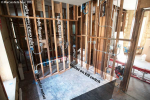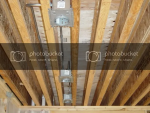LarryFine
Master Electrician Electric Contractor Richmond VA
- Location
- Henrico County, VA
- Occupation
- Electrical Contractor
On the jobs you did with MC, did the "C" stand for cable or for conduit?I have a couple of pics of a restaurant we wired years ago. I used MC everywhere it wouldn't show, and EMT where it would.
View attachment 2554070 View attachment 2554072
Metal Clad is a cable type.On the jobs you did with MC, did the "C" stand for cable or for conduit?
On the jobs you did with MC, did the "C" stand for cable or for conduit?
FMC is not limited to 6 feet.
It is limited to 6 feet when allowed and used as the EGC, but if you pull a green there is no length limitation.
There is no unsupported whip rules that can apply either when over six feet, so if your whip is more than six feet you need to follow the general support rules.



emt and nail plates???Not sure if you know this but he's from Chicago, they still wire full houses in EMT and have crazy restrictions on different wiring methods in certain areas. I don't know all the details but I know they don't like Romex or flexible wiring methods very much.
Tips for EMT in dwelling unit
Hi all. Long time, no post; hope all of you are well. Normally, I don't get involved with too much residential work, but a buddy of mine -- who does mostly residential -- stepped aside and recommended me for this job because the contractor has mandated it be done in EMT due to local ordinance...forums.mikeholt.com
View attachment 2554073
View attachment 2554074
View attachment 2554075
I noticed that too on the first picture. Didn’t see it on the last two.emt and nail plates???~RJ~
EMT, Nail Plates, AND Firestop!emt and nail plates???~RJ~
"Oh my!"EMT, Nail Plates, AND Firestop!
The point I was trying to make w/ @kwired is that my original comment NEVER claimed that ALL FMC was limited to 6 ft. It was a very short, general statement, that wasn't even the focus of my comment, that there are length limitations w/ FMC that can make things tricky... and there are length limitations in the NEC, as he himself points out.Not sure if you know this but he's from Chicago, they still wire full houses in EMT and have crazy restrictions on different wiring methods in certain areas. I don't know all the details but I know they don't like Romex or flexible wiring methods very much.
I know what MC is, just wondered what the "C" stands for, I was thinking Cable but Larry reminded me CladYou don't know what MC is? What are you, some kind of residential only guy?
He posted pictures of it going to those boxes. See Art. 330.
-Hal
hmm, well i guess i learned something here today!Generally speaking, MC and even EMT are considered no more "armored" than NM cable. Thus the nail plates over EMT.
What do they have for us on Metal studs? I've seen metal studs that definitely would not have the 1.25 inch setback for the cable run holes.Generally speaking, MC and even EMT are considered no more "armored" than NM cable. Thus the nail plates over EMT.
What do they have for us on Metal studs? I've seen metal studs that definitely would not have the 1.25 inch setback for the cable run holes.
With metal studs and MC cable no protection is required when running through holes in the studs even if the stud holes are less than 1.25" from the edge. 1 5/8" studs are used all of the time with MC cable through the holes in the studs and no protection.What do they have for us on Metal studs? I've seen metal studs that definitely would not have the 1.25 inch setback for the cable run holes.
Eh, I don't know about that one. I think your conclusion here ignores the reality of a grey area between two absolutes. It's a scale.Generally speaking, MC and even EMT are considered no more "armored" than NM cable. Thus the nail plates over EMT.
You sure? I thought they were if it's a certain distance from the edge?I would also add that nail plates are not required for EMT through studs.
You can't prove that by me, lol.With metal studs you run the cables through the punched openings which are large enough to allow the cable to move out of the way of a nail or screw.
-Hal
If it's not an NEC requirement, then it's either another building code issue like IRC or a local amendment. I know I got it from somewhere and didn't just invent it. I was introduced to nail plates long before I ever installed my first NM. So I know I'm not conflating NM requirements with EMT.I would also add that nail plates are not required for EMT through studs.

